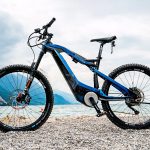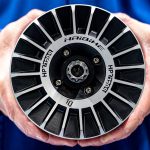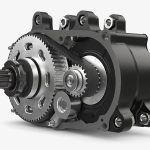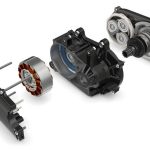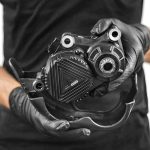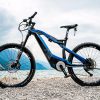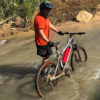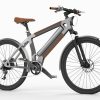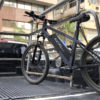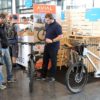250W e-Bike drive systems: mid-drive vs rear (front) hub. What should I choose?
7.09.2021
7545
Most of today’s modern e-Bikes are equipped with a front wheel-drive, rear wheel-drive or mid-drive. So, what’s the difference? How are the benefits or drawbacks of a rear hub-motor or front hub-motor versus a mid-drive system? As many people start to select an e-Bike with 250W drive, the question is frequently asked – Hub-motor or Mid-drive? Which is better? Which one is right for exactly my operating conditions?
My opinion is that each 250W drive type: front, rear or mid-drive, has advantages and drawbacks, so the choice has to be based on the circumstances in which you intend to use your e-Bike and, to a large extent, depends on your driving style. Unless you have experience of your very own, then regardless of the opinions of pundits and experts (myself included), I would encourage you to test-drive these three main types of drives. It will give you a taste of the different types of drive systems, and then you can choose a particular e-bike from the manufacturer and a particular model.
All arguments given by me and the conclusions made by me in this article do not pretend to be an expert, since they are based on my personal experience of using and testing at bicycle shows a couple of dozen models of middle-drive vs rear hubs e-bike motors with 250W power. Here’s hoping they help you be more informed in your choice.
Excluding from this review e-Bike Conversion Kits designed for installation on regular, non-electric bikes, i.e. the systems that integrate a motor with a battery in the same housing [1] and Kits that can be fitted instead of the classic bike’s front or rear wheel, as well as drive kits that replace the pedal assembly’s typical bottom bracket, like the Bafang BBS02B or Bikee Bike Kit [2], there is a selection among 250W drives for production or customized electric bikes: Rear, MID, Front or, in some cases, Full.
Mid-drives 250W are available in series models, including famous brands Bosch [3], Shimano [4] and others, but also less well-known ones, such as Bafang [5] or COMP (Vinka) [6], which makes them far less attractive, especially for those doing electric bikes with their hands.
I would distinguish the three groups among them: the more common and fitted with a standard gear, such as Bosch, Shimano, Bafang, Brose [7], drives with a round body, such as the German TQ [8] or the Chinese Eecycle [9]. For the new 3rd generation TQ mid-drive the planetary gears have been changed to a single Cycloidal gearbox, because currently this type is the most space-saving and the lightest possible gearbox. In the third group, we may distinguish actuators with an automatic transmission, such as the Finnish development Revonte ONE [10].
I had no much experience with automatic transmissions. I have not bought it for two reasons: high cost and quite a big weight. Talking about weight, I base it on the mass of a regular motor that operates in cooperation with classic drivetrain, such as a Shimano Deore. That said, in my mind this kind of drive is a good option for cargo cycle applications, where cost, mass and size are not so critical anymore.
Mid-drive systems 250W with a regular gearbox form the core of the range of most manufacturers: Bosch, Shimano, Bafang, Brose, COMP (Vinka), etc. The most important values for me here are thrust and dynamics, based on torque and RPM of the motor. They are the ones that offer more options when traveling on hilly terrain, as well as in the process of active city maneuvering. Any of the mid-drives can work with the chain transmission, the belt transmission with the transmission system in the rear wheel-hub and, even a driveshaft (for example, the company Bafang has a model M445).
Second most important to me are smoothness of work, predictability, and the weight and noise of the drive. Smoothness of operation is the responsibility of the speed or torque sensors, which work in combination or separately. COMP (Vinka) has developed an additional gearshift transducer that lowers the motor power at the time of shift, allowing you to switch gears with no load or jerk, making for a more seamless cycling experience. That’ s why two year ago I chose the 250W mid-drive from COMP (Vinka) – it has the classic gear, 80Nm of torque, an average weight of 3.8kg and, it runs quite quietly in comparison with many other analogs.
The 250W round-body mid-motors are, in my view, the market leaders. When I tested the TQ 120S drive for my first time, weighing 3.9 kg with 120Nm of torque, I was just amazed by its pulling power and response. The only reason I didn’t pick one for myself that the cost of this particular drive was out of my project’s range. It should be noted that there are more affordable drives of this type made in China, for example, the Eecycle with a torque of 110Nm weighing about 5 kg and in my plan to find an opportunity and test one of them.
The specifications of some 250W mid-drive models:
| Manufacturer / specifications | COMP С17 | Vinka S20 | TQ 120S | Brose Drive T | Bosch Performance | Shimano DU-EP800 | Bafang M300 | TranzX M17 |
| Power (W) | 250 | 250 | 250 | 250 | 250 | 250 | 250 | 250 |
| Torque (Nm) | 80 | 60 | 120 | 70 | 85 | 85 | 80 | 85 |
| Voltage (V) | 36 | 36 | 48 | 36 | 36 | 36 | 36 | 36 |
| Weight (kg) | 3.8 | 2.5 | 3.9 | 3.4 | 3.2 | 2.6 | 3.6 | 3.2 |
Conclusions: The 250W mid-drives offer spectacular torque, a fairly light weight that may be minimal on certain models, a broad range of adjustments and sensors that not only provide great traction, but also smooth ride when working together with both chain and belt drive systems.
The installed 250W mid-drive gives the electric bike good balance and a low gravity center, providing the feel of a traditional bicycle ride. These drives are good for low-speed rides when uphill and, at the meantime, use less power. Although, in certain cases, you’ll have to use more foot force to get the exact same velocity as with a rear-driven power equivalent.
The flip side of this can be the increased transmission wear and tear, because it not only has as much force to handle as you put through your pedals but also the high torque of the drive that’s transmitted.
Something I’ve run into more or less before is that it’s a whole lot easier to change a tire on a bike with a mid-drive motor.
250W Rear and front drives. I grouped them together in one group because they differ structurally only by mounting on the rear stays dropouts or on the bike front fork. The torque of such motors, in relation to mid-drives systems is not high and usually amounts to 30-45Nm, which is sufficient for comfortable use in city traffic conditions. The price of such a motor is not high and can be 3-4 times less than a mid-drive. Such drives can be subdivided into two directions: with direct drive (without a gearbox) and second – motors are equipped with a planetary gear.
Direct-drive motors, because of the no gearbox, have a relatively simple design and, consequently, are very reliable. The axis in them, which goes through its center, is in fact the axis itself of the drive. Their main drawback is the weight, which may be 1.5-2 times more than the weight of a similar model equipped with a planetary reduction gear. Moreover, the presence of the gearbox provides some benefit in traction, particularly at the start of the movement.
250W Hub-motors with a reduction gear can have a weight of 1.8 to 2.2 kg and a torque of up to 60Nm, which lets install them on the front wheel as well as on the rear wheel without particularly affecting the weight distribution of the bicycle. Geared motors have bodies that are connected to the motor stator via a planetary reduction gear system. With each full turn of the body, the motor inside rotates many times faster. That allows the hub-drive to run at higher and more efficient speeds. The front-wheel-drive option will provide the ability to be equipped with a belt drive with the geared transmission in a rear wheel hub. Rear-drive bicycle models are available as either single-speed or chain-driven and gear shifter models.
The bottom line is that you have to choose between a gear drive or a motor with a direct drive based on their two basic characteristics. If you need a lightweight bicycle with a 250W motor, there is simply no substitute for a lightweight, compact planetary gear motor. If you are searching for an electric bike with more than 500W, a direct drive motor might be the right choice.
Specifications of some 250W front drives and rear drives:
| Manufacturer / specifications | Vinka RH40 | TranzX M16 | Bafang HR H400 | Bafang HF H400 | SR Suntour R250 HP | SR Suntour F250 HP | DP Motors M130 | Neodrives Z20 |
| Power (W) | 250 | 250 | 250 | 250 | 250 | 250 | 250 | 250 |
| Torque (Nm) | 45 | 45 | 30 | 45 | 60 | 40 | 35 | 40 |
| Voltage (V) | 36 | 36 | 36 | 36 | 36 | 36 | 36 | 36 |
| Weight (kg) | 3.0 | 1.9 | 3.0 | 2.3 | 3.2 | 2.3 | 2.6 | 4.0 |
Conclusions: The 250W motors for front- and rear-drive bicycle wheel hubs are very light and have an intermediate torque rating, suitable primarily for urban use. Their design is very straightforward and relatively inexpensive.
Most of the batteries are mounted in the center or rear of an electric bicycle, and this means that the use of a front-wheel drive will contribute to the better distribution of weight. Some people may feel, though, that the handling here is comparatively heavier than on mid-drive models. Although, in my opinion, the front-wheel drive just takes a little getting used to, remembering that in icy, mud or slushy conditions, the front wheel drive might lack traction, because the front wheel can slip on the start or when going uphill.
Most of cyclist body weight is carried by the rear wheel of the bike, so a rear hub motor can deliver more traction than a front hub motor due to better wheel grip. Rear-wheel drive bicycles are similar in many ways to their rear-wheel drive car counterparts and, both of them, are capable of giving more vivid, lively and exciting sensations while driving.
Mid-drive vs rear- (front-) hub drive: Conclusion
If we stop on the still popular fuel vehicles, then we can say that the driving performance of 250W motors for rear or front wheel drive is conventionally commensurate with the capabilities of a 1.6 liter gasoline engine. A e-bike with a 250W mid-drive motor is able to give a dynamic feeling, in some ways similar to riding a car with a 2.0-liter turbo diesel engine.
The 250W mid-drive gives the potential electric bike owner more options both in the field of flexibility in configuration options via a computer and in equipping with various types of transmissions. This allows you to get a more expensive, but at the same time, a multifunctional bike with ample opportunities for movement in a wide variety of road conditions.
Equipped with 250W front or rear wheel drive, the modern electric bike is slightly lighter and, more importantly, cheaper than its mid-drive counterpart by 20-25%. This configuration makes it possible for the cyclist to feel great on urban asphalt or during country trips on country roads with slight hilly terrain.
The consumer qualities, performance and technical abilities of 250W drives determine in many respects the product line of Avial Bikes electric bikes, which at the moment consist of models with mid-drive 250-350W, as well as rear-drives 250-1000W.
Baruch Dorfman
In detail:
[1]Hycore T1 multifunctional smart bicycle wheel – https://avialbikes.com/news/hycore-t1-is-an-e-bike-kit-made-in-the-form-of-a-bicycle-rear-wheel/
[2] Bikee Bike Mid-drive kit – https://avialbikes.com/news/mid-drive-e-bike-conversion-kit-the-scales-at-a-claimed-1-6-kg/
[3] Bosch e-Bike Drive Systems – https://www.bosch-ebike.com/us/products/drive-units
[4] SHIMANO high-end e-bike components – https://www.shimano-steps.com/e-bikes/europe/en
[5] Bafang electric bike Drive Systems – https://bafang-e.com/home/
[6] COMP (Vinka) e-Bike Systems – https://www.vinka.jp. Currently, the company COMP has suspended its operations and, all e-Bike drive systems are available now under the brand of the manufacturer Vinka.
[7] Brose e-Bike drives – https://www.brose-ebike.com/de-en/products/
[8] TQ powerful e-bike drive solutions – https://www.tq-group.com/en/products/tq-e-mobility/
[9] Eecycle Mid-Drive Motor – https://www.eecycle.com/mid-drive-motor/
[10] Revonte ONE e-Bike drive system with Automatic Transmission – https://revonte.com
